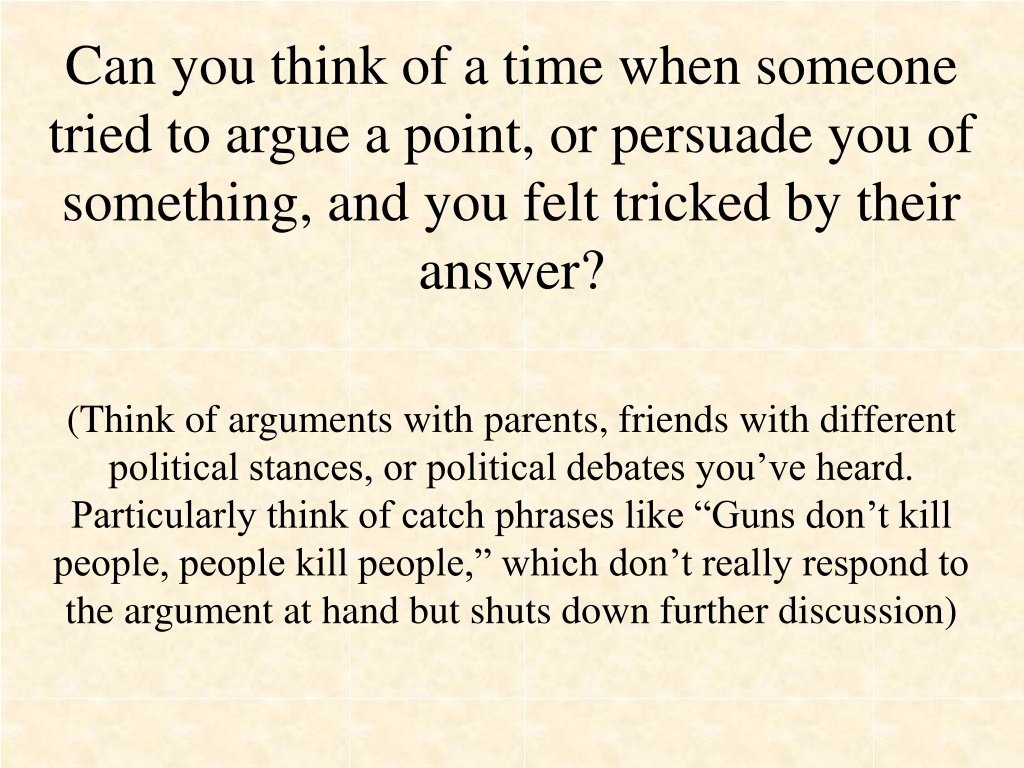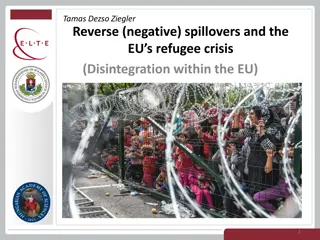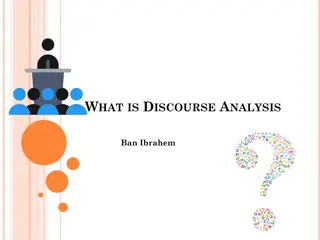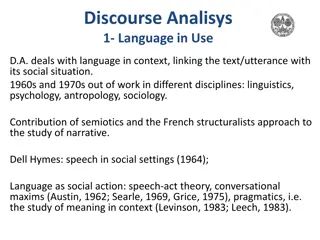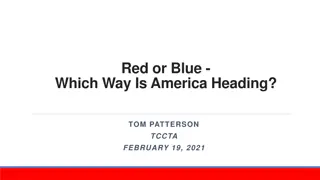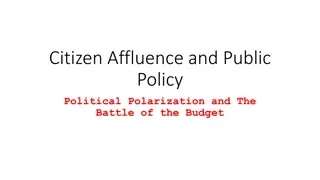Understanding Demagoguery and Polarization in Public Discourse
Demagoguery in public discourse polarizes by simplifying complex issues into binary choices, encouraging ingroup/outgroup thinking and scapegoating. Motivism dismisses rational reasons for actions, attributing them to dark motives. Scapegoating projects responsibility onto outgroups, dehumanizing them. Critical rhetoric is necessary to foster inclusive and productive debates that do not exclude marginalized voices.
Download Presentation

Please find below an Image/Link to download the presentation.
The content on the website is provided AS IS for your information and personal use only. It may not be sold, licensed, or shared on other websites without obtaining consent from the author. Download presentation by click this link. If you encounter any issues during the download, it is possible that the publisher has removed the file from their server.
E N D
Presentation Transcript
Can you think of a time when someone tried to argue a point, or persuade you of something, and you felt tricked by their answer? (Think of arguments with parents, friends with different political stances, or political debates you ve heard. Particularly think of catch phrases like Guns don t kill people, people kill people, which don t really respond to the argument at hand but shuts down further discussion)
Demagoguery Demagoguery shuts down the ability to have a productive debate. A leader who tells people that they can stop thinking and simply act (and act simply) as s/he dictates frees people of responsibility (70) Roberts-Miller ascribes two main traits to demagogic rhetoric: It polarizes It encourages ingroup/outgroup thinking.
Can we develop a critical rhetoric that articulates standards for good public discourse that does no exclude the already excluded? (Roberts-Miller 65)
Terms within Roberts-Millers essay: Demagoguery is polarizing propaganda that motivates members of an ingroup to hate and scapegoat some outgroup(s) (66) Demagogues may try to intensify the sense of polarization (66) Polarization: Demagogues polarize a complicated situation by presenting only two options: their policy, and some obviously stupid, impractical, or shameful one (66)
Motivism: Motivism is the assertion that people don t really have reasons for what they do, but they are motivated by something else some dark motive; evil, lust, hatred, etc. (83) Ingroup/Outgroup Thinking: demagogues rely on a common way for people to view the world: there are some people whom we think of as like us in some important regard, and others who are very different from us (66)
Scapegoating: Scapegoating has been usefully defined as denial through projection. Individuals (or communities can deny responsibility for a situation by projecting that responsibility onto some outgroup (68) Scapegoating often dehumanizes, or demonizes, the outgroup that is blamed. This is one of the major attractions of demagoguery : it takes a tremendously complicated situation, about which people are very anxious, and makes them feel better by presenting a simple solution : elimination of the outgroup and promotion of the ingroup (69)
Simple solutions A rhetoric of fear Use of fallacies which violate the rules for productive discourse RM describes.
10 Rules for productive discourse: (Taken from Van Eemeren and Grotendoorst) 1. No engaging in personal attack, because it prevents the disagreement from happening, thereby precluding its being resolved (70) 2. Interlocutors are obliged to defend their standpoint, rather than shift topic or manipulate proof (70) 3. Interlocutors must attack the standpoint really presented by their opponent (71) 4. Interlocutors must defend their standpoint with relevant forms of argumentation, rather than by manipulating their audience s emotions (71)
5. Interlocutors must accurately represent the unexpressed premises of themselves and other (71) 6. Both parties must accurately represent the accepted starting point (71) 7. No interlocutor can declare the argument conclusively defended (72) 8. An interlocutor cannot force the other party to accept evidence (72) 9. People must change their minds if they fail to defend a standpoint or if the other people succeed in defending theirs (72) 10. No mystagoguery the attempt to triumph in discourse through being so unclear that no one can disprove the argument (because no one understands it)
You should also try to locate elements of LaPierre s text that are effective and exemplify productive, reaonable (ethical) discourse
Fallacies A misstep in reasoning. Roberts-Miller takes this a step further by arguing that fallacies undermine our ability to engage in fair, open, productive discourse; they risk persuading by manipulating an audience. Obviously, fallacies are matters of degree and involve interpretation and argument. When considering whether an argument contains a fallacy, you must consider questions of audience, purpose and context. Reasoning that is weak or fallacious in one context may be persuasive and credible in another.
Slippery Slope (Domino Theory): The common fallacy that "one thing inevitably leads to another." E.g., "If you two go and drink coffee together one thing will lead to another and soon enough you'll be pregnant and end up spending your life on welfare living in the projects
Straw Man: The fallacy of setting up a phony, ridiculous version of an opponent's argument and then proceeding to knock it down. E.g., "Vegetarians say animals have feelings like you and me. Ever seen a cow laugh at a Shakespeare comedy? Vegetarianism is nonsense!"
False Analogy: Incorrectly comparing one thing to another to draw a false conclusion. E.g., "Just like an alley cat needs to prowl, a normal person can t be tied down to one single lover." Today's Dilbert Comic
Ad Hominem Argument: The fallacy of attempting to refute an argument by attacking the opposition s personal character or reputation, using a corrupted negative argument from ethos. E.g., "He's so evil that you can't believe anything he says. Appeal to Pity: The fallacy of urging an audience to root for the underdog regardless of the issues at hand (e.g., Those poor, cute little squeaky mice are being gobbled up by mean, nasty cats that are ten times their size! ) A corrupt argument from pathos. We Have to Do Something (Scare Tactics): The fallacy that in moments of crisis one must do something, anything, at once, even if it is an overreaction (E.g., "Banning air passengers from carrying knitting needles onto the plane and making babies take off their little pink baby-shoes probably does nothing to deter hijackers, but we have to do something! ) Loaded Question: Aloaded question is a question which contains a controversial or unjustified assumption. Such questions may be used as a rhetorical tool: the question attempts to limit replies to be those that serve the questioner's agenda ( answer yes or no! ) E.g. An activist outside Love Library stopping passerby s with the question, Do you want to stop world hunger? How does someone say no? It d be much easier to give an answer and walk away if the question was framed as Do you want to give money to our organization today?
What fallacies or instances of demagoguery, can you find in LaPierre s speech?
Using a text as a lens: Demagoguery is polarizing propaganda that motivates members of an ingroup to hate and scapegoat some outgroup(s) (Roberts-Miller) In ancient times, a demagogue was a leader of the people; a popular orator who espouses the cause of the people against any other party in the state (OED)
Body paragraph 1 1. Identify the characteristic of demagoguery you will focus on. Explain how Roberts-Miller defines this term, and why she thinks it is a problem. Use a quotation from RM and explain the quote ( what she means by this is ) Identify two or more places in LaPierre where there is evidence of the element of demagoguery (try to find the best examples) Give examples (use quotations) and explain how/to what extent the examples fit RM s definition. Make a case for your interpretation (be like a lawyer this is key). It may be that the examples only fit RM s definition to some degree. Explain this. Explain why these strategies may have been used in the context, and the possible effects on the audience. Explain why, according the RM, using such a strategy is problematic. 2. 3.
